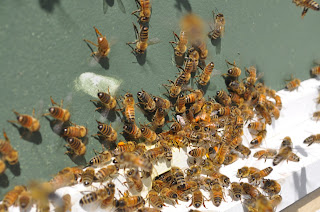I received my packages of bees last saturday, and hived them the same day. Here's a picture of my 4 hive setup. .
I get the plastic pallets from shipments of food that we receive. I don't really have a very good market for them; I sell them for $1 each for folks to put under their hay, but they work great for holding up hives; pallets can hold up thousands of pounds of weight, and give you plenty of roof for two hives and a place to work. I put down 4 pallets so that I don't have to bend over too much when I'm working with the bees, and only 4 so that I don't have to reach too high when I'm putting the supers on for honey later in the year.
The hives are the green boxes. The white boxes peeking over are extra supers that I'm storing there next to the hives. The white "cap" is actually two parts; a thick styrofoam lid and a bee feeder. These packaged bees come in with no food stores at all, so to give them a good start I feed them a simple syrup that is 1 part water to 1 part sugar, by weight. Actually, granulated white sugar is about the same weight as water, by volume, so you can get pretty close just by measuring out the same volumes of water and sugar.
This is what the inside of one of the feeders looks like. There's a clear plastic guard that is L shaped, and the bees crawl up and then over a wall to get to the syrup. It's pretty normal to see a couple of hundred bees doing this when you open it up. A feeder will hold about 5 gallons of the syrup, but I only put in a gallon at a time to keep it relatively fresh.
One of the hives just isn't figuring out the feeder though; only a few bees sipping it. So I took the guard off and then scooped up some of the syrup and poured it down the crack that the bees enter through. An hour later and they'd found it. If they don't find and utilize the syrup it will really slow down their growth.
I hived them on Saturday, make sure that the queens had escaped their queen box on sunday and removed them, and then on monday checked to make sure that they were utilizing their syrup. They were flying pretty well, and seemed very interested in pollen; there's apparently several sources nearby. In the picture above you can see some yellow pollen on the legs of the bee.
In the picture above you can see some florescent orange pollen that they found somewhere. I think it's salmon berry; that's the only thing that is that particular color of orange that comes to mind. You can see several bees carrying it. Click the picture for a bigger version.
I did notice that several of the bees were fanning; which is what they do when they think that the hive is too hot, or that it's too humid, so I removed the hive entrance limiters for a couple of hours to allow them to adjust their temperature and humidity more easily.
Looking forward to working with the bees again this year.
1 week ago












1 comment:
I always admire the bravery of the blogs that deal with bees. love fresh honey but can't deal with the stings.
Post a Comment